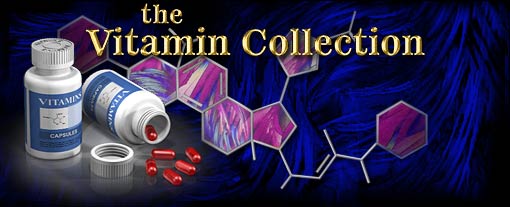
|
|
Adenine (Vitamin B-4) - Purine that is definitely not a vitamin. Amygdalin (Vitamin B-17, Laetrile) - Anticancer agent and vitamin--not! Anthranilic Acid (Vitamin L) - A factor originally thought to be important for lactation. Ascorbic Acid (Vitamin C) - One of the most ubiquitous vitamins ever discovered. Beta-Carotene (Vitamin A precursor) - Yellow pigment that forms vitamin A. Biotin (Vitamin H) - Carbon dioxide carrier that builds fats. Cholecalciferol (Vitamin D) - The vitamin made from rich sunlight. Cyanocobalamin (Vitamin B-12) - A vitamin that treats pernicious anemia. Folic Acid (Folate, Vitamin B-9) - A vitamin that helps fetus development during pregnancy. Inositol (Myo-Inositol) - A useful sugar once thought to be a!vitamin. Menadione (Vitamin K) - A fat-soluble vitamin that helps to clot blood. Niacin (Nicotinamide, Vitamin B-3) - A pyridine important in nucleic acid metabolism. PABA (Para-aminobenzoic acid, Vitamin B-x) - Bacterial vitamin that serves as a sunscreen. Pangamic Acid (Vitamin B15) - The non-vitamin "vitamin" that cures everything. Pantothenic Acid (Pantothenate, Vitamin B-5) - Important for normal growth. Pyridoxine (Pyridoxal phosphate, Vitamin B-6) - A very versatile coenzyme. Retinol (Vitamin A) - The first vitamin to be discovered. Riboflavin (Vitamin B-2) - The vitamin that gives urine its yellow color. Thiamine (Vitamin B-1) - A sure cure for Beriberi. Alpha-Tocopherol (vitamin E) - What some people call the "love" vitamin is really a free radical scavenger. Questions or comments? Send us an email© 1995-2025 by Michael W. Davidson and The Florida State University. All Rights Reserved. No images, graphics, software, scripts, or applets may be reproduced or used in any manner without permission from the copyright holders. Use of this website means you agree to all of the Legal Terms and Conditions set forth by the owners.
This website is maintained by our
|